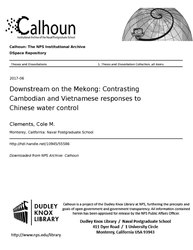File:Downstream on the Mekong- Contrasting Cambodian and Vietnamese responses to Chinese water control (IA downstreamonmeko1094555586).pdf

Original file (1,275 × 1,650 pixels, file size: 1.18 MB, MIME type: application/pdf, 102 pages)
Captions
Captions
Summary[edit]
| Downstream on the Mekong: Contrasting Cambodian and Vietnamese responses to Chinese water control
( |
||
|---|---|---|
| Author |
Clements, Cole M. |
|
| Title |
Downstream on the Mekong: Contrasting Cambodian and Vietnamese responses to Chinese water control |
|
| Publisher |
Monterey, California: Naval Postgraduate School |
|
| Description |
Decreasing supplies of fresh water, growth of the global population, and the transnational nature of much of the world's water resources have made global competition over water increasingly common. In Southeast Asia, Chinese hydroelectric dams at the Lancang Cascade have enabled China to control the headwaters of the Mekong River and threaten downstream states' access to this vital resource. Cambodia and Vietnam are two Southeast Asian states whose economic prosperity is inextricably linked to undisturbed access to the Mekong. Despite similar requirements for river usage, the two states have responded to Chinese control in surprisingly different ways. This thesis investigates the different Vietnamese and Cambodian responses to China's Mekong River development by analyzing their requirements for the Mekong River and contrasting each state's relationship with China. The thesis finds that Cambodia has developed a strategy of appeasement toward China, placing its short-term interests in Chinese economic assistance ahead of its long-term requirements for riparian productivity, while Vietnam has balanced against the super power, demonstrating the resolve to protect its riparian interests. Similarly, the two states both use institutions to offset the super power's significant size and power advantages, providing them an alternative path to shape China's actions. Subjects: China; Cambodia; Vietnam; Mekong; water security; hydroelectric dams; Lancang Cascade; Mekong River Commission; institutions |
|
| Language | English | |
| Publication date | June 2017 | |
| Current location |
IA Collections: navalpostgraduateschoollibrary; fedlink |
|
| Accession number |
downstreamonmeko1094555586 |
|
| Source | ||
| Permission (Reusing this file) |
This publication is a work of the U.S. Government as defined in Title 17, United States Code, Section 101. Copyright protection is not available for this work in the United States. | |
Licensing[edit]
| Public domainPublic domainfalsefalse |
This work is in the public domain in the United States because it is a work prepared by an officer or employee of the United States Government as part of that person’s official duties under the terms of Title 17, Chapter 1, Section 105 of the US Code.
Note: This only applies to original works of the Federal Government and not to the work of any individual U.S. state, territory, commonwealth, county, municipality, or any other subdivision. This template also does not apply to postage stamp designs published by the United States Postal Service since 1978. (See § 313.6(C)(1) of Compendium of U.S. Copyright Office Practices). It also does not apply to certain US coins; see The US Mint Terms of Use.
|
 | |
| This file has been identified as being free of known restrictions under copyright law, including all related and neighboring rights. | ||
https://creativecommons.org/publicdomain/mark/1.0/PDMCreative Commons Public Domain Mark 1.0falsefalse
File history
Click on a date/time to view the file as it appeared at that time.
| Date/Time | Thumbnail | Dimensions | User | Comment | |
|---|---|---|---|---|---|
| current | 15:05, 17 July 2020 |  | 1,275 × 1,650, 102 pages (1.18 MB) | Fæ (talk | contribs) | FEDLINK - United States Federal Collection downstreamonmeko1094555586 (User talk:Fæ/IA books#Fork8) (batch 1993-2020 #14220) |
You cannot overwrite this file.
File usage on Commons
The following page uses this file:
Metadata
This file contains additional information such as Exif metadata which may have been added by the digital camera, scanner, or software program used to create or digitize it. If the file has been modified from its original state, some details such as the timestamp may not fully reflect those of the original file. The timestamp is only as accurate as the clock in the camera, and it may be completely wrong.
| Short title | Downstream on the Mekong: Contrasting Cambodian and Vietnamese responses to Chinese water control |
|---|---|
| Author | Clements, Cole M. |
| Software used | Clements, Cole M. |
| Conversion program | Adobe PDF Library 11.0 |
| Encrypted | no |
| Page size | 612 x 792 pts (letter) |
| Version of PDF format | 1.4 |

